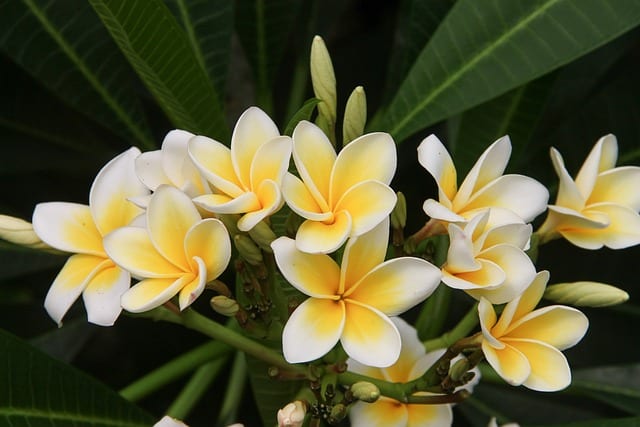Plumeria is a tropical plant that is known for its fragrant flowers and attractive appearance. However, plumeria owners may experience yellowing of the leaves with brown spots, which can be a sign of a problem.
Understanding the causes of yellow leaves and brown spots on plumeria leaves can help diagnose and treat the issue, and prevent further damage to the plant.
There are several factors that can contribute to plumeria leaf discoloration, including soil conditions, pH levels, lack of nutrition, mineral deposits, overwatering, and underwatering.
In addition, diseases and pests can also cause brown spots on plumeria leaves, such as black tip fungus, rust, and spider mites. Identifying the underlying cause of plumeria yellow leaves brown spots is crucial to determine the appropriate treatment and prevent the issue from recurring.
In this article, we will delve into the topic of plumeria yellow leaves brown spots, including how to identify diseases and pests, the factors that contribute to leaf discoloration, treatment and prevention methods, plumeria care during winter, and how to recover an affected plumeria.
We will also answer some frequently asked questions to provide a comprehensive guide for plumeria owners.
Understanding Plumeria Yellow Leaves Brown Spots
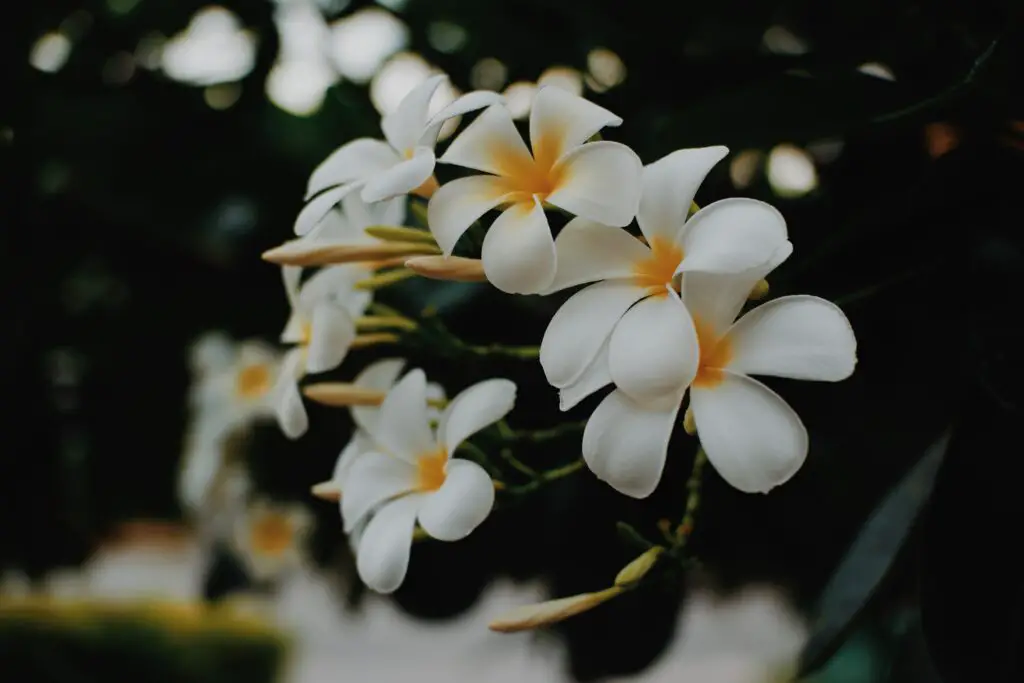
Plumeria is a tropical plant known for its beautiful and fragrant flowers. However, it is not uncommon for plumeria leaves to turn yellow or develop brown spots. Understanding the causes of these issues is crucial in preventing further damage to the plant.
Don’t miss out on these other top picks in this caregory:
- Plumeria Brown Spots on Leaves
- Philodendron Leaves Turning Yellow with Brown Spots
- Why Does My Rubber Plant Have Brown Spots?
Yellow Leaves
Yellow leaves are a common problem in plumeria plants, and there can be several reasons for this issue. One of the most common reasons for yellow leaves is overwatering. Plumeria plants need well-draining soil and should be watered only when the top inch of soil is dry. Overwatering can lead to root rot, which can cause yellow leaves.
Another reason for yellow leaves is underwatering. Plumeria plants need regular watering, especially during the growing season. If the plant is not watered enough, the leaves can turn yellow and eventually fall off.
Brown Spots
Brown spots on plumeria leaves can be caused by several factors. One of the most common causes of brown spots is a fungal disease called plumeria rust. This disease is caused by the fungus Coleosporium plumeriae, which appears as brown spots on the leaves.
Another reason for brown spots is sunburn. Plumeria plants need full sun to produce the best blooms, but too much sun, especially during the hottest hours of the day, can cause brown spots on the leaves.
Treatment and Prevention
Treating plumeria yellow leaves and brown spots depends on the underlying cause. For yellow leaves caused by overwatering, it is important to reduce watering and ensure the soil is well-draining. For underwatering, the plant should be watered regularly.
To treat plumeria rust, affected leaves should be removed and destroyed to prevent the spread of the disease. Fungicides can also be used to control the disease.
To prevent brown spots caused by sunburn, plumeria plants should be placed in a location that receives full sun but is protected from the hottest hours of the day. Providing shade during these hours can also help prevent sunburn.
Identifying Diseases and Pests
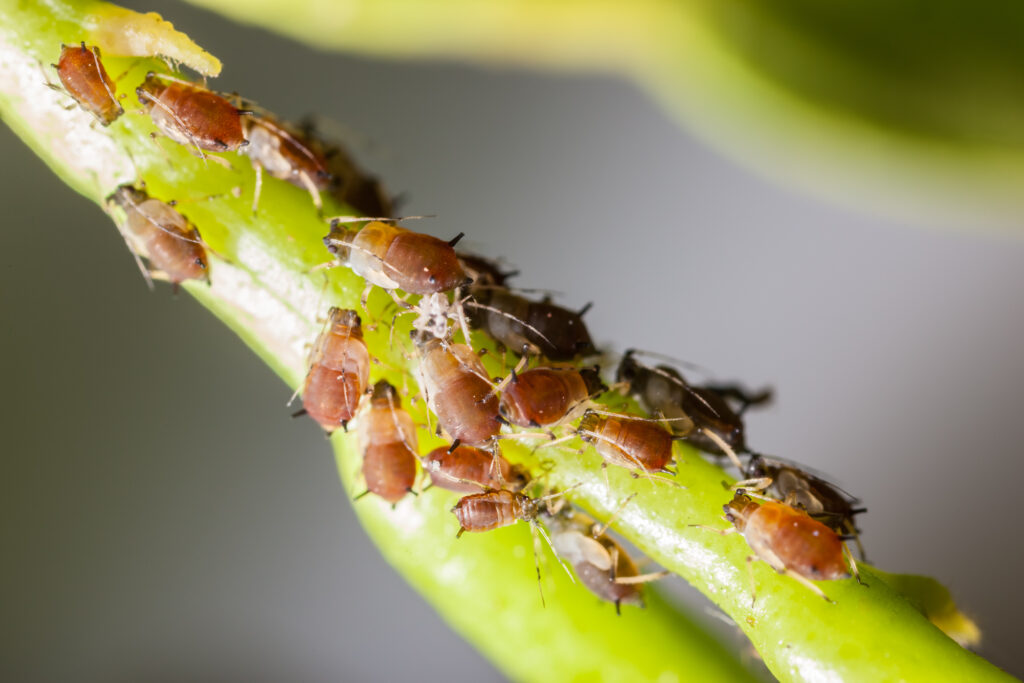
Plumeria plants are susceptible to various diseases and pests that can cause yellow leaves and brown spots. Identifying the cause of the problem is crucial to finding the right treatment. This section will cover the most common diseases and pests that affect plumeria plants.
Fungal Diseases
Fungal diseases are a common cause of yellow leaves and brown spots in plumeria plants. One of the most common fungal diseases that affect plumeria plants is Plumeria rust.
This disease is caused by the fungus Coleosporium plumeriae and is characterized by yellow leaves with brown spots and powdery orange spores on the underside of the leaves.
Another fungal disease that affects plumeria plants is anthracnose. This disease is caused by the Colletotrichum gloeosporioides fungus and is characterized by brown spots on the leaves and stems. Infected leaves may also have a sunken appearance.
If you suspect that your plumeria plant has a fungal infection, it is essential to remove infected leaves and stems immediately to prevent the spread of the disease. Fungicides can also be used to treat fungal infections in plumeria plants.
Pest Infestation
Pest infestation is another common cause of yellow leaves and brown spots in plumeria plants. Mites and mealybugs are two of the most common pests that affect plumeria plants.
Mites are tiny insects that can be difficult to see with the naked eye. They feed on the sap of the plant, causing yellow leaves and brown spots. Mealybugs, on the other hand, are small, white insects that feed on the sap of the plant and leave behind a sticky residue.
To prevent pest infestation in plumeria plants, it is essential to keep the plant healthy and well-maintained. Regularly inspect the plant for signs of pests and remove any infected leaves or stems immediately. Insecticidal soaps or oils can also be used to treat pest infestations in plumeria plants.
Factors Contributing to Leaf Discoloration

Plumeria plants are known for their vibrant and colorful blooms, but yellow leaves and brown spots can be a common issue for gardeners. Several factors can contribute to leaf discoloration in plumeria plants, including watering issues, sunlight exposure, and soil and nutrient deficiency.
1. Watering Issues
Watering is a crucial aspect of plumeria plant care, and overwatering or underwatering can lead to yellow leaves and brown spots. Overwatering can cause root rot and fungal diseases, leading to yellow leaves with brown spots. On the other hand, underwatering can cause leaves to curl and turn yellow, leading to brown spots.
To avoid overwatering or underwatering, plumeria plants should be watered deeply once a week during the growing season, and less often during the dormant season. Gardeners should also ensure proper drainage by planting plumerias in well-drained soil and using pots with drainage holes.
2. Sunlight Exposure
Plumeria plants require full sun to produce their best blooms, but too much sunlight can cause leaves to develop brown spots. Direct sunlight during the hottest hours of the day can cause leaves to burn and turn brown, leading to discoloration.
To avoid sunlight exposure issues, plumeria plants should be planted in a location that receives full sun for at least six hours a day. Gardeners should also provide shade during the hottest hours of the day, especially during the summer months.
3. Soil and Nutrient Deficiency
Soil and nutrient deficiency can also contribute to leaf discoloration in plumeria plants. Plumerias require well-drained soil with a pH between 6.0 and 7.0, and nutrient deficiencies can cause yellow leaves with brown spots.
To avoid soil and nutrient deficiency issues, gardeners should ensure their plumeria plants are planted in well-drained soil with proper pH levels. Plumerias also require regular fertilization with a balanced fertilizer, including magnesium, to prevent nutrient deficiencies.
Treatment and Prevention
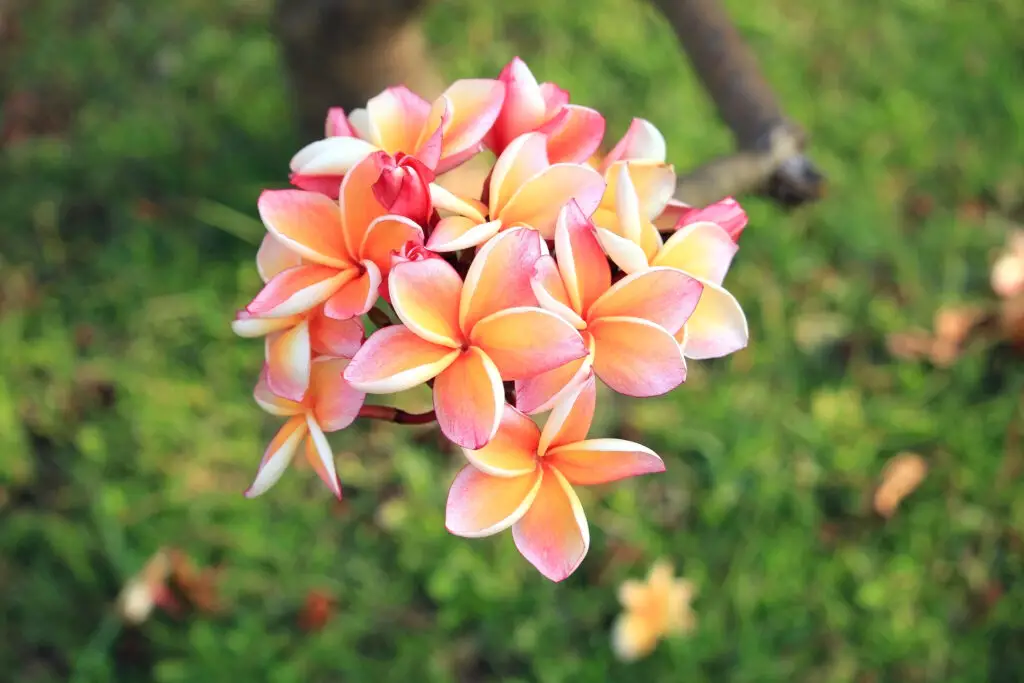
Plumeria plants are susceptible to yellow leaves and brown spots, which can be caused by various factors such as fungal infections, pests, improper watering, and sunlight exposure. Here are some effective ways to treat and prevent these issues.
Fungicide Application
If the yellow leaves and brown spots are caused by fungal infections, using fungicides can be an effective treatment. Bayleton and copper oxychloride are some of the most popular fungicides for plumeria plants.
However, it is important to follow the instructions on the label carefully when applying fungicides to avoid damaging the plant.
Proper Watering and Sunlight
Proper watering and sunlight exposure are crucial for the health of plumeria plants. Overwatering can cause root rot and lead to yellow leaves, while underwatering can cause the leaves to turn brown and fall off.
It is important to water the plant only when the soil is dry to the touch, and avoid getting water on the leaves as this can promote fungal growth.
Plumeria plants need full sunlight to produce the best blooms, but too much sun exposure can cause the leaves to develop brown spots. It is recommended to provide the plant with partial shade during the hottest hours of the day to prevent sun damage.
Pest Control
Pests such as spider mites and whiteflies can also cause yellow leaves and brown spots on plumeria plants. Insecticidal soap and horticultural oil are effective treatments for these pests. Neem oil is also a popular natural pesticide that can be used to control a wide range of pests.
Regularly inspecting the plant for signs of pest infestation and treating them promptly can prevent the spread of the infestation and minimize damage to the plant.
Plumeria Care During Winter

Plumeria plants go dormant during the winter months, and their care requirements change accordingly. During this period, plumeria plants should be watered less frequently, and the amount of sunlight they receive should be reduced.
It is important to note that plumeria plants should not be watered too much during the winter months. Overwatering can lead to root rot, which can be fatal to the plant. It is recommended to water the plant only when the soil is dry to the touch.
Plumeria plants also require less sunlight during the winter months. They should be placed in a location that receives indirect sunlight for most of the day. Placing them in a location that receives direct sunlight can cause the leaves to develop brown spots.
It is also important to note that plumeria plants are sensitive to cold temperatures. They should be kept in a location where the temperature is above 50°F (10°C). If the temperature drops below this, the plant can suffer damage.
Recovering an Affected Plumeria
If a plumeria is affected by yellow leaves or brown spots, it is important to take immediate action to save the plant. Here are some steps that can be taken to recover an affected plumeria:
- Pruning: If the plumeria has yellow leaves or brown spots, it is important to remove the affected leaves and branches. Cut off the affected parts of the plant using a sterilized pruning tool, and dispose of them properly. This will help prevent the spread of any diseases or pests to other parts of the plant.
- Isolate: If the plumeria is infected with a disease or pest, it is important to isolate the plant from other plants to prevent the spread of the problem. Move the affected plant to a separate location and avoid contact with other plants until the problem is resolved.
- Resistant Varieties: Some plumeria varieties are more resistant to diseases and pests than others. Consider planting a more resistant variety if the problem is persistent.
- Regulate Water Intake: Overwatering can lead to root rot, which can cause yellow leaves or brown spots on the plumeria. Make sure to regulate water intake and avoid overwatering the plant.
- Apply Proper Treatment: There are various treatments available for plumeria diseases and pests. Consult a professional or use a trusted source to identify the problem and apply the proper treatment.
Frequently Asked Questions
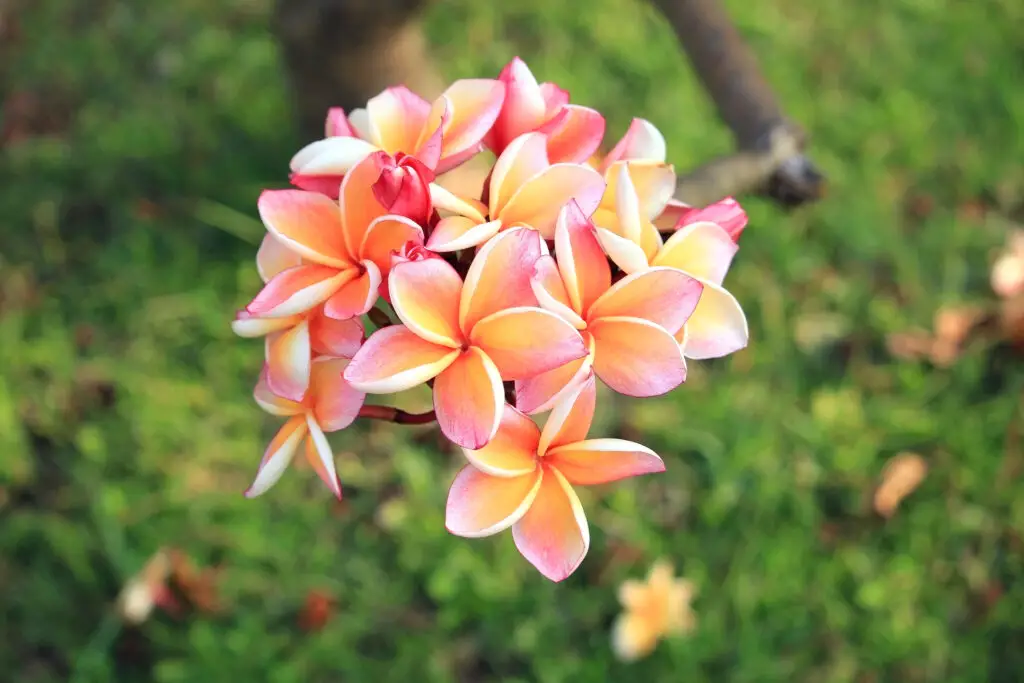
What causes yellowing and brown spots on plumeria leaves?
Yellowing and brown spots on plumeria leaves can be caused by a variety of factors. Some of the most common causes include overwatering, underwatering, nutrient deficiencies, pests, diseases, and environmental stressors such as too much or too little sunlight.
How can I prevent my plumeria leaves from turning yellow?
To prevent your plumeria leaves from turning yellow, make sure to provide them with the right amount of water, nutrients, and sunlight. Plumeria plants need well-draining soil and should be watered deeply but infrequently.
They also require regular fertilization with a balanced fertilizer. Additionally, make sure to protect your plumeria from pests and diseases by keeping a clean and healthy growing environment.
What is the best way to treat brown spots on plumeria leaves?
The best way to treat brown spots on plumeria leaves depends on the underlying cause. If the brown spots are caused by a fungal disease such as plumeria rust, you may need to use a fungicide to treat the infection.
If the brown spots are caused by overwatering, you will need to adjust your watering practices to prevent further damage. In general, it is important to identify the cause of the brown spots before attempting any treatment.
Why do plumeria leaves turn yellow in winter?
Plumeria leaves may turn yellow in winter because the plant is dormant during this time and requires less water and nutrients. It is important to reduce watering and fertilization during the winter months to prevent overwatering and nutrient deficiencies.
How do I identify and treat plumeria rust?
Plumeria rust is a fungal disease that can cause yellowing and brown spots on plumeria leaves. To identify plumeria rust, look for yellow-orange powdery spots on the undersides of the leaves.
To treat plumeria rust, you may need to use a fungicide such as copper sulfate or neem oil. It is also important to remove any infected leaves and keep the growing environment clean and dry.
What are some signs of overwatered plumeria and how do I fix it?
Signs of overwatered plumeria include yellowing leaves, brown spots, and root rot. To fix overwatered plumeria, you will need to reduce watering and improve drainage by repotting the plant in well-draining soil.
You may also need to remove any damaged or rotting roots to prevent further damage.

Hey, I’m Lisa and I’ve been an avid gardener for over 30 years. I love writing, talking and living in the garden! Feel free to connect with me on my socials below

